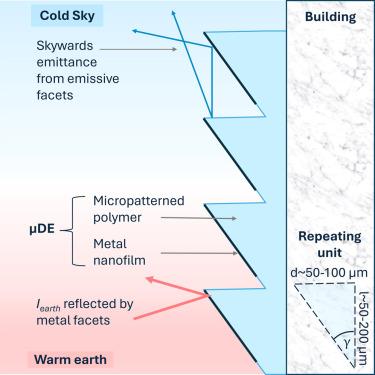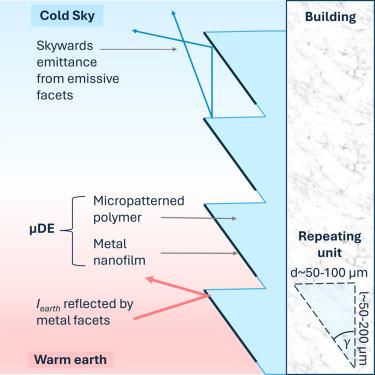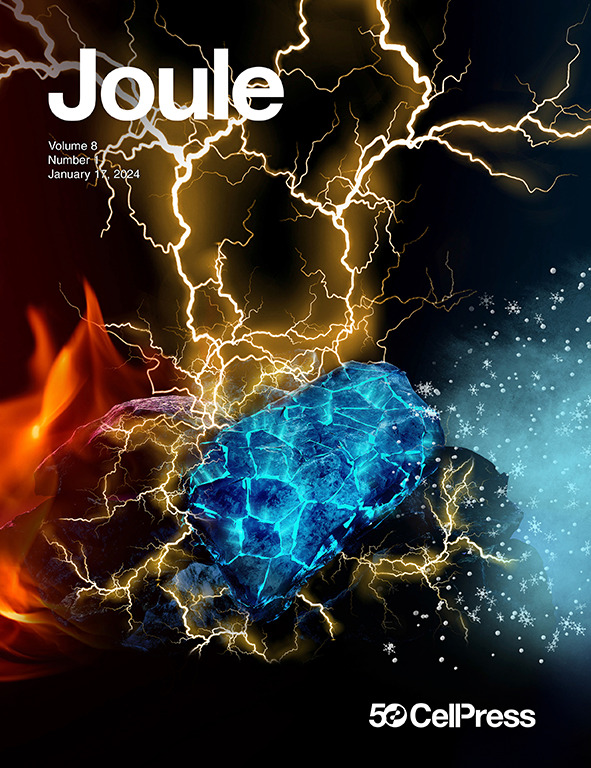超越冷却:地球发光中的辐射温度调节与微图案定向发射器
IF 35.4
1区 材料科学
Q1 CHEMISTRY, PHYSICAL
引用次数: 0
摘要
我们展示了一种具有超宽带定向热发射的微图像化定向发射体(μDE)。μDE通过减少地面热流,实现了以前未开发的被动季节性建筑温度调节。μ de具有金属和白色外观,可以使用低成本材料和可扩展的制造技术来制造,并且可以根据不同的城市场景进行几何定制定向发射度。我们还展示了一种新颖的、可见的透明变体。在室外实验中,μDEs在温暖天气下比传统全向围护结构降温1.53 ~ 3.26℃,在寒冷天气下比传统全向围护结构降温0.46℃。此外,相对于典型的建筑围护结构,我们的μ de在温暖条件下具有高达40 W.m - 2的冷却能力,在寒冷条件下具有高达35 W.m - 2的加热能力。建筑能源模型表明,μDEs可以实现与冷屋顶相似或更高的全季节节能。总的来说,我们的研究结果表明μDEs在温度调节建筑物中非常有前途。本文章由计算机程序翻译,如有差异,请以英文原文为准。


Beyond cooling: Radiative thermoregulation in the Earth’s glow with micropatterned directional emitters
We demonstrate a micropatterned directional emitter (μDE) with an ultrabroadband directional thermal emittance. The μDE enables a previously unexplored passive seasonal thermoregulation of buildings by reducing terrestrial heat flows. μDEs with metallic and white appearances can be made using low-cost materials and scalable manufacturing techniques and have their directional emittance geometrically tailored to different urban scenarios. We also show a novel, visibly transparent variant. In outdoor experiments, μDEs stay 1.53°C to 3.26°C cooler than traditional omnidirectional building envelopes in warm weather and up to 0.46°C warmer in cold weather. Additionally, our μDEs demonstrate significant cooling powers of up to 40 W.m−2 in warm conditions and heating powers of up to 35 W.m−2 in cool conditions relative to typical building envelopes. A building energy model shows that μDEs can achieve all-season energy savings similar to or higher than those of cool roofs. Collectively, our findings show μDEs as highly promising for thermoregulating buildings.
求助全文
通过发布文献求助,成功后即可免费获取论文全文。
去求助
来源期刊

Joule
Energy-General Energy
CiteScore
53.10
自引率
2.00%
发文量
198
期刊介绍:
Joule is a sister journal to Cell that focuses on research, analysis, and ideas related to sustainable energy. It aims to address the global challenge of the need for more sustainable energy solutions. Joule is a forward-looking journal that bridges disciplines and scales of energy research. It connects researchers and analysts working on scientific, technical, economic, policy, and social challenges related to sustainable energy. The journal covers a wide range of energy research, from fundamental laboratory studies on energy conversion and storage to global-level analysis. Joule aims to highlight and amplify the implications, challenges, and opportunities of novel energy research for different groups in the field.
 求助内容:
求助内容: 应助结果提醒方式:
应助结果提醒方式:


